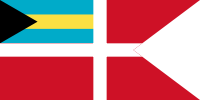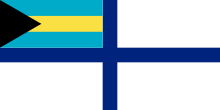Bahamas|
|
 |
| Use |
National flag |
|---|
| Proportion |
1:2 |
|---|
| Adopted |
July 10, 1973 |
|---|
| Design |
A horizontal triband of aquamarine (top and bottom) and gold with the black equilateral triangle based on the hoist-side. |
|---|
| Designed by |
Dr. Hervis Bain[1][2] |
|---|
|
|
The national flag of the Bahamas consists of a black triangle situated at the hoist with three horizontal aquamarine, yellow and aquamarine bands. Adopted in 1973 to replace the British Blue Ensign defaced with the emblem of the Crown Colony of the Bahama Islands, it has been the flag of the Commonwealth of the Bahamas since the country gained independence that year. The design of the present flag incorporated the elements of various submissions made in a national contest for a new flag prior to independence.
History
The Bahamas became a crown colony of the United Kingdom within its colonial empire in 1717.[3] Under colonial rule, the Bahama Islands used the British Blue Ensign and defaced it with the emblem of the territory. This was inspired by the ousting of the pirates, and consisted of a scene depicting a British ship chasing two pirate ships out at the high seas encircled by the motto "Expulsis piratis restituta commercia" ("Pirates expelled, commerce restored"). The emblem was designed in around 1850, but did not receive official approval until 1964.[4]
The Bahama Islands were granted "internal autonomy" in 1964.[3] After the 1972 elections, the territory started negotiations on independence.[3][5] A search for a national flag began soon after, with a contest being held to determine the new design. Instead of choosing a single winning design, it was decided that the new flag was to be an amalgamation of the elements from various submissions.[4] It was first hoisted at midnight on July 10, 1973, the day the Bahamas became an independent country.[4][6] The new country also changed its name from the Bahama Islands to the Bahamas upon independence.[7]
Design
Symbolism
The colors of the flag carry cultural, political, and regional meanings. The gold alludes to the golden sand and the shining sun– as well as other key land-based natural resources[4] – while the aquamarine epitomises the sea surrounding the country. The black symbolizes the "strength",[4][8] "vigor, and force" of the Bahamian people, while the directed triangle evokes their "enterprising and determined" nature to cultivate the abundant natural resources on the land and in the sea.[9]
Here is a partial official description. "The colours embodied in the design of the Bahamian flag symbolise the image and aspirations of the people of The Bahamas; the design reflects aspects of the natural environment (sun, sand, and sea) and the economic and social development. The flag is a black equilateral triangle against the mast, superimposed on a horizontal background made up of two colours on three equal stripes of aquamarine, gold and aquamarine."
Legal issues
The Bahamian flag is often used as a flag of convenience by foreign merchant vessels. Under the Law on Merchant Shipping Act 1976 (amended in 1982), any domestic or foreign vessel – regardless of country of origin or place of registration – can be registered in the Bahamas "without difficulty".[10] Furthermore, the ship's crew is not restricted by nationality and "ordinary crew members" have "virtually no requirements for qualification".[10] This lack of regulation has led to ships flying flags of convenience – like the Bahamas' flag – having a reputation of possessing a "poor safety record".[11] This came to light in November 2002, when a Greek oil tanker flying the flag of the Bahamas split into two and sank in the Atlantic Ocean off the north-western Spanish coast. This produced an oil slick of 60,000 tons of petroleum.[12]
Historical flags
| Flag | Duration | Use | Description |
.png) |
1869-1904 |
Flag of the Crown Colony of the Bahama Islands |
A British Blue Ensign defaced with the emblem of the crown colony. This consisted of a British ship chasing two pirate ships out at the high seas and the motto "Expulsis piratis restituta commercia" (Pirates expelled, commerce restored). |
.svg.png) |
1904-1923 |
Flag of the Crown Colony of the Bahama Islands |
The crown on the crest was changed to a domed Tudor crown. |
.svg.png) | 1923–1953 | Flag of the Crown Colony of the Bahama Islands | The crown on the crest was changed to an Edwardian-style crown. |
.svg.png) | 1953–1964 | Flag of the Crown Colony of the Bahama Islands | A British Blue Ensign defaced with the emblem of the crown colony featuring a queen's crown for the new queen. |
Maritime flags
 |
 Civil ensign. Flag Ratio: 1:2 Civil ensign. Flag Ratio: 1:2 |
|
 |
| Civil jack. Flag Ratio: 1:2 |
|
 |
 Naval ensign. Flag Ratio: 1:2 Naval ensign. Flag Ratio: 1:2 |
|
 |
| Flag of the Auxiliary Fleet of the Navy. Flag Ratio: 1:2 |
|
References
- ↑ "Dr Bain Joins The Fabulous Forty". Tribune 242. 2013-06-13. Retrieved 2015-03-15.
- ↑ "Our national flag, a symbol of true national pride". Freeport News. Retrieved 2015-03-15.
- 1 2 3 "Bahamas profile". BBC News. BBC. Retrieved July 2, 2014.
- 1 2 3 4 5 Smith, Whitney (October 6, 2013). "Flag of the Bahamas". Encyclopædia Britannica. Encyclopædia Britannica, Inc. Retrieved July 2, 2014. (subscription required)
- ↑ "History of The Bahamas". Lonely Planet. Retrieved July 2, 2014.
- ↑ McJunkins, James (July 10, 1973). "New Flag Hoisted Over Bahamas". The Palm Beach Post. p. A1. Retrieved July 2, 2014.
- ↑ Albury, E. Paul (October 7, 2013). "The Bahamas – Independence". Encyclopædia Britannica. Encyclopædia Britannica, Inc. Retrieved July 2, 2014. (subscription required)
- ↑ {{https://www.tripsavvy.com/are-bermuda-and-the-bahamas-in-the-caribbean-1487679}}
- ↑ "Bahamas, The". The World Factbook. CIA. Retrieved July 2, 2014.
- 1 2 Egiyan, G.S. (March 1990). "‘Flag of convenience’ or ‘open registration’ of ships". Marine Policy. Elsevier. 14 (2): 106–111. doi:10.1016/0308-597x(90)90095-9. (registration required)
- ↑ Kelly, Nicki (May 11, 1983). "Bahamas becomes newest ship registration center". The Christian Science Monitor. Boston. p. 10. Retrieved July 2, 2014. (subscription required)
- ↑ Ordás, M. C.; Albaigés, J.; Bayona, J. M.; Ordás, A.; Figueras, A. (2007). "Assessment of In Vivo Effects of the Prestige Fuel Oil Spill on the Mediterranean Mussel Immune System". Archives of Environmental Contamination and Toxicology. Springer Publishing. 52 (2): 200–206. doi:10.1007/s00244-006-0058-7. Retrieved July 2, 2014. (registration required)
External links
|
|---|
| Sovereign states | |
|---|
Dependencies and
other territories | |
|---|
|
|---|
| National flags | |
|---|
| National coats of arms | |
|---|

.png)
.svg.png)
.svg.png)
.svg.png)



